THE LOST EPISODES: ZAPPA'S TEENS
Zappa's interest in more than one musical direction already showed itself in his teens. On one side he had the ordinary interest among teenagers in the popular music of the fifties, like rhythm and blues and close harmony vocal songs, called doo-wop. He played in some high school bands, the first one named the Blackouts. A photograph of this band has for instance been published in "The real Frank Zappa book" and the one below, where we can see him sitting behind the drums, his first instrument. At the age of eighteen, he started to learn how to play guitar, the instrument that would bring him reputation in the future.
Lost in a whirlpool
An example of Zappa playing guitar at this time has actually been
kept. It's a blues improvisation with him playing lead guitar in E Dorian, his brother Bobby on rhythm
guitar and their friend Don van Vliet singing the lyrics instantly about being lost in a
whirlpool.
Lost in a whirlpool, 0:00-0:20 (midi file).
Lost in a whirlpool, 0:00-0:20 (transcription).
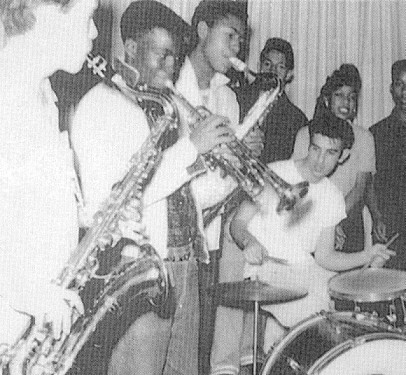 Zappa: "While all other guys spent all their money on cars, I bought records (I didn't have a car). I went to second hand stores to buy jukebox records with rhythm and blues songs
[...]. Don was also an R&B maniac, so I took my singles to his house and we listened for
hours to obscure hits by Howlin' Wolf, Muddy Waters, Sonny Boy Williamson, Guitar Slim, Johnny "Guitar"
Watson, [...]" (Real FZ book). It was recorded in an empty classroom
on a Webcor reel-tot-reel that happened to be standing there and the song
is included on "The lost episodes".
Zappa: "While all other guys spent all their money on cars, I bought records (I didn't have a car). I went to second hand stores to buy jukebox records with rhythm and blues songs
[...]. Don was also an R&B maniac, so I took my singles to his house and we listened for
hours to obscure hits by Howlin' Wolf, Muddy Waters, Sonny Boy Williamson, Guitar Slim, Johnny "Guitar"
Watson, [...]" (Real FZ book). It was recorded in an empty classroom
on a Webcor reel-tot-reel that happened to be standing there and the song
is included on "The lost episodes".
The Blackouts with FZ behind the drumset.
Section of a photo from the Patrice
Zappa collection (reproduced in her "My brother was a mother" book).
Zappa had no natural gift for instrumental virtuosity and his capacities as a guitar player grew
through the passing of the years. Jimmy Carl Black, his drummer in the sixties, commented that
in 1964 Zappa was not a great guitar player at that time. When he was able to play the guitar he
left the drumset, but there are a few recordings from the early sixties with Zappa playing the
drums (for instance "Anyway the wind blows" on "The Lost Episodes"; see the Cucamonga years section) and occasionally he would play percussion instruments on his later albums.
At the same time he became wildly enthusiastic about the music of Edgar Varèse, one of the
atonal modern composers, who called his compositions organized sound, having absolutely nothing in common with the pop music of the fifties.
He was able to get a copy of volume 1 of the three record set with Varèse's complete orchestral works conducted by Robert Craft.
The influence of Varèse on Zappa was not so much that Zappa became a follower of Varèse, but that it stimulated his ambitions to become a composer of modern music.
In the left menu of this site you can find a discussion taking place between me and an American scientist, Brett Clement.
It's very interesting material with its main benefit being that it enticed me to look at a large number of compositions anew and deepen the analysis of them.
About blues Brett writes:
"Blues aspects in Zappa range from full-on 12-bar blues based music (ex. Road Ladies) to blues-styled solos over static one-chord vamps (ex. The Gumbo Variations).
Almost without fail, Sloots analyzes these situations as Dorian or Mixolydian. In certain cases, he is simply wrong
(ex. Lost in a Whirlpool/Been to Kansas; basically, there is no way that the 12-bar blues can be labeled as strictly Dorian).
In others, there is a possibility that the term "Dorian" could be used to describe the music, but with an important qualification: [etc.]"
See the Imaginary diseases section of this study at "Been to Kansas City in A minor"
for the full citation and a lot of comment. In this case Brett has a point. In the example above Frank is soloing following solely E Dorian
(my guess would be that Brett prefers to call it minor pentatonic with the C# from bar 4 being incidental).
Bobby is using the following chord scheme:
- bars 1-4: E9
- bars 5-6: A7
- bars 7-8: E9
- bar 9: B7
- bar 10: A#dim-B7
- bar 11: E9-B7
- bar 12: E9-A#dim-B7 (Frank and Bobby)
In a 12-bar blues scheme the chord upon the tonic takes up 8 of the 12 bars, so the E9 chord points at E Mixolydian.
Using Dorian and Mixolydian next to each other is common in Zappa's music (the Guitar section of
this study gives an overview). The other chords from the scheme, however, evade from
E Mixolydian. There's no adequate musical term covering a situation as this. Chromatic or atonal aren't an option, polyscalar doesn't describe it properly.
Lost in a whirlpool, 1:50-2:24 (midi file).
Lost in a whirlpool, 1:50-2:24 (transcription).
In this second example the rhythm has changed to 4/4 with triplets, or 12/8 with the equasion: a dotted fourth note in this example = a fourth note in the previous example.
Both Frank and Bobby are now playing around the chord scheme rather loosely, the soloing is limited. The sound quality isn't such to get at a very accurate transcription, nor am I sure
about who is playing which note at any point.
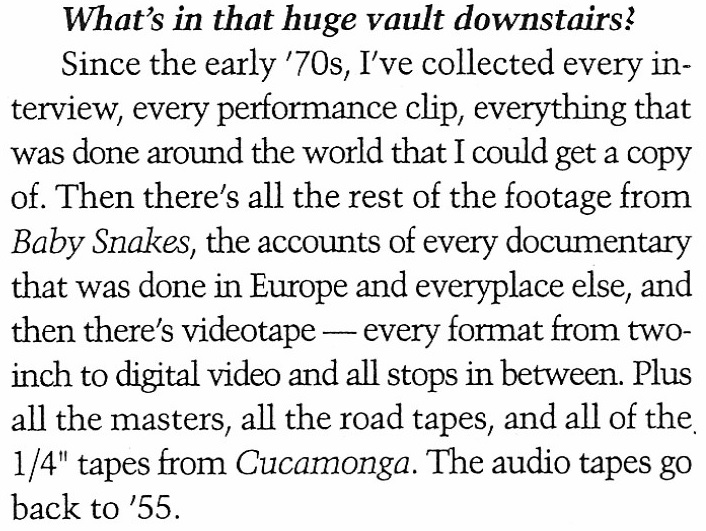
Zappa talking about his archive, known as the Vault (Zappa! issue by Guitar Player, page 45), suggesting audio tapes go back to 1955. In the 2020 Zappa documentary by Alex Winter
you can see some examples from videos that Zappa made with his parents' camera (below: two thumbnails with his brother Bobby and mother Rose, pretending to participate in a scary movie). Some of these oldest tapes are in a poor condition, about to decay. In the documentary it gets said
the ZFT is considering transferring (part of) the Vault to the Smithsonian Institute.
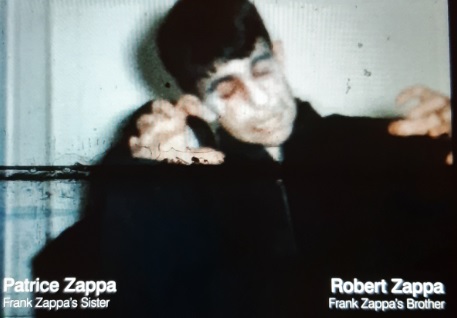
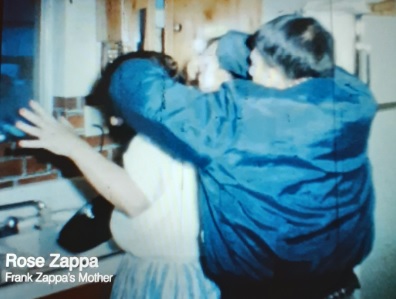
The string quartet, mvt. I: Pound for a brown/The legend of the golden arches
If you take his word for it, all his early compositions were modern music for small ensembles.
One of them is "Pound for a brown". On the album liner notes of "The yellow shark" he's
saying: "The tune dates from 1957 or '58. It was originally a string quartet I wrote right about
the time I graduated (from high school). It's one of the oldest pieces, and it's been played
by just about every one of the touring bands, in one version or the other". Its tune became
one of Zappa's favorites. It made its first appearance on the "Uncle meat" album of 1968 in two versions. The first version carries a
different title, namely "The legend of the golden arches". The main theme is given here below. This theme has several characteristics that return more often in Zappa's music:
- The theme is melodic as a starting point. The instruments are moving freely through the keys. Harmonically it's a free blending of
the notes. The harmonies formed at a specific point
can be both traditional and untraditional chords. The whole can hardly be seen as a form of a chord progression in traditional terms.
- Two instruments can be playing in parallels, fourths and thirds in this case. Others are giving
complementary movements. It's built up in layers, the staffs in the transcription are combinations of instruments and at some points
it's difficult to exactly hear the individual notes.
- The melody itself has no tonal centre, but is played over a basso ostinato figure. The figure starts with
B as pedal note, so the key becomes B Mixolydian in the first 7 bars, determined by this pedal note of the
accompaniment. It has various chromatic elements in it. For bars 8-9 the ostinato figure briefly changes. The figure itself uses both an A and an A#, but
the other instruments are using solely an A#, so these two bars are more in B major. In the third printed edition of this study
these two bars had C# as a pedal note, but I misheard
that; the transcription had to be renewed with the Martin Herraiz study as a reason for it (page 246, see the literature references).
In bar 10 we're back at B Mixolydian. The chords formed by the basso ostinato figure
are untraditional. The underlying chord in the bass in bars 1-7
is in rock terms referred to as Esus4, in classical harmony it's part of for instance the VII 9th chord of B Mixolydian
with two of the notes from this chord skipped.
The legend of the golden arches, theme (midi file).
The legend of the golden arches, theme (transcription).
"Pound for a brown" was used during many tours, including additional opportunities for the band members to improvise.
There are versions on "Ahead of their time" and "You can't do that on stage anymore IV" and "V". It got its final and
most elaborate version as a chamber orchestra piece on "The yellow shark". During the sixties the Mothers of Invention still used to refer
to this piece as the string quartet, with "Sleeping in a jar" as its second movement (it's played that way on "Ahead of their time").
It can also be seen named this way on the ZFT release "Meat light".
Apparently Zappa only started titling these two pieces for the "Uncle meat" album. In this album's version of
"Pound for a brown" the string quartet set-up is still readily detectable: the two violins must have played staff 1,
the viola staff 2 and the cello staff 3.
Rhythms and meters to a degree allow notational variants. In the study by Brett Clement you can see that he chose for notating the melody
as 3/4 plus 4/4, being played over two periods of the ostinato figure. This solves the hemiola from bar 2 to 3 in staff 1 in my example.
In this study I'm inclined to always let downbeats determine the meter, but there are situations where one might choose for a different approach:
- Village of the sun: my 3/8 plus 5/8 bar can also be notated as two times 4/8, so that the meter remains constant.
- Wind up working in a gas station: my 17/16 plus 15/16 bars can also be notated as two times 4/4, the standard meter for rock songs.
Without a change of meter you would get heavy hemiolas on both occasions, including the downbeat. The above Clement notation solves one hemiola in the melody,
but creates a new one from bar 4 to 5 when listening to all parts. This concerns the E-B at the beginning of bar 5. As quarter notes they would go over the bar
line in the Clement notation. In the Herraiz example on page 246 of his study this is getting notated as if this isn't happening. The E and B get cut off
to an eighth note. There are many examples in Zappa's music using two meters simultaneously. The ones from my study are listed in the Roxy and
elsewhere section. In the arrangement by Robert Peate from 2010 yet again different meter notations are chosen. For the second half
of the main theme, he's using 4/4 and 2/4. Let's say it's undecided how it should best be notated.
Other related examples included in this study:
- "The legend of the golden arches": the middle section of this composition, as how it got played
on "Uncle Meat".
- "A pound for a brown on the bus": a version with electronically mutated clarinets,
playing in very high registers.
- "Pound for a brown (1978)": theme, middle section and soloing from the 1978 tour.
- "Pound for a brown (1982)": start of the guitar solo from the 1982 tour.
- "Pound for a brown (1993)": bars from the middle section of this composition, Ensemble Modern version.
The string quartet, mvt. II: Sleeping in a jar
One can't immediately recognize a string quartet set-up in case of "Sleeping in a jar". One could create a string quartet
arrangement, but there are no clues in the later executions how the original string quartet version might have sounded.
On the "Uncle meat" album "Sleeping in a jar" is played as single melody, made up of two phrases, played only once, as if Zappa
only wanted to touch upon this theme. It ends with a peculiar coda with a sequence of fast high notes. On "Ahead of their time" it's given a more normal
structure, combining it with other themes and letting the main theme return. On "Playground psychotics" you can find another
live version of "Sleeping in a jar (1971)" with Zappa playing two little guitar solos in it.
See the corresponding section for the end of this version.
Sleeping in a jar, theme (midi file).
Sleeping in a jar, theme (transcription).
Uncle Meat:
- 0:00 Central theme, phrase A ("It's the middle..."), played twice.
- 0:21 Central theme, phrase B ("Sleeping, mum and dad...").
- 0:31 Outro
- 0:49 End
Ahead of their time:
- 0:00 Intro
- 0:23 Central theme, phrase A (instrumentally), played twice.
- 0:39 Central theme, phrase B (idem), played half as slow.
- 0:56 Intermezzo with two smaller side themes and vocal improvisations.
- 1:37 Central theme, phrase A (instrumentally), played twice.
- 1:52 Central theme, phrase B (idem), played half as slow.
- 2:08 Outro
- 2:24 End
Waltz for guitar
Of a different nature is the score of an example of a twelve-tone peace, called "Waltz for guitar", that has been
printed in total in Zappa! (see the references). Twelve-tone compositions were fashionable among modern composers at that
time and Zappa shortly tried to go along with them. It's a straightforward academic piece, composed at the age of
eighteen. I've written down the numbers of the string at the beginning. This guitar waltz stood model for the atonal
intermezzo in "Brown shoes don't make it" (see the Absolutely free section).
Waltz for guitar, opening (midi file).
Waltz for guitar, opening (score).
In Zappa!, page 30, he reflected upon this sidestep: "I mean, I had heard some 12-tone piece by other composers that I liked, which is one of
the reasons I went in that direction, but as a system it was too limiting
for me. I asked myself the basic question: If the intrinsic value
of the music depends on your serial pedigree, then who the fuck is going to know whether
it's any good or not? Only the people who sit down with the score and a magnifying glass
find out how nicely you've rotated these notes. And that's pretty boring. So I started
moving in the direction of a more haphazard style. That's what sounded good to me for whatever reason, whether
it was some crashing dissonance or a nice tune with chord changes and a steady beat
in the background".
From that perspective it's peculiar to notice that he continued to admire Anton Webern. In chapter II of the Real FZ book, he writes:
"The other composer who filled me with awe -
I couldn't believe that anybody would write music like that - was Anton Webern.
I heard an early recording on the Dial label with a cover by an artist named David Stone Martin - it had one or two of Webern's string quartets,
and his Symphony op. 21 on the other side. I loved that record, but it was about as different from Stravinsky and Varèse as you could get."
In Zappa!, page 58, he also commented that he liked some, though far from all, works by Arnold Schoenberg and Alban Berg, mentioning Schoenberg's
"Septet" and Berg's "Lyric suite". While the influence of Stravinsky (for instance regarding changing meters) and Varèse (for instance upon the use of percussion
and collage-like constructions) can be easily recognized, this doesn't go for Webern. Other than the "Waltz for guitar", I've only pointed at
the use of pauses in my analysis of "Is there anything good inside of you (see the One size fits all section). But of course one can like a composer without
being influenced by that person in your own music.


Waltz for guitar, end (midi file).
Above the opening bars and final bars of the "Waltz for guitar" in Zappa's own handwriting from 1958. It's a composition of one page with 22 bars. Here it carries the title "Waltz #1", implying the existence of at least
another waltz from this period. In Zappa! it's notated for guitar, thus an octave higher as it sounds. There are a couple of examples in this study of his scores in his original handwriting. When you lay them next to each
other it becomes easy to recognize them. This is his handwriting at the age of 18, very neat at that time. His "mature" handwriting became more fluid,
but remained clearly legible. Aspects that are typical of him is to put the meter with numbers in a larger font-size in front for a couple staffs at once (instead
of for each staff separately), as well as shortening bows. He's not doing the second here yet. He also had a preference for writing texts with capitals only.
The comparison of his handwriting over decades indicates that the "© 1958 by Frank Zappa" and "spezial copy for Nedra" words were added later on, during
the seventies or later. As also the deliberate misspelling of "special" does. In the final three bars you can see the 12-tone string turn
up for the last time: G-F#-A#-A-E-Ab(G#)-D-Eb(D#)-B-F-Db(C#)-C.
Mice - The Blackouts
This last paragraph of this section is about two relics, that aren't that much musically relevant, but historically.
In a couple of interviews Zappa has called "Mice" the first, maybe second, composition he wrote. He did this at
the age of fourteen, when it was a requirement to play a mini-solo on drums to be in the drum section of the high school band.
Details can be found at http://globalia.net/donlope/fz/songs/Mice.html. On
this page you can find an mp3 outtake from the NBC Midnight Special interview from
1976, where you can hear him commenting upon this composition and singing how the beats went from recollection. In the example
below I've notated both the beats in drumset notation and the way Zappa is simulating it as "ra-ta-ta-tan" etc.
It sounds credible and it's teasing to know
he kept some of these very old scores in his archive. There may be
more than the pieces from above.
Mice (snare drum solo), sample (midi file).
Mice, sample - The Blackouts, fragment (transcription).
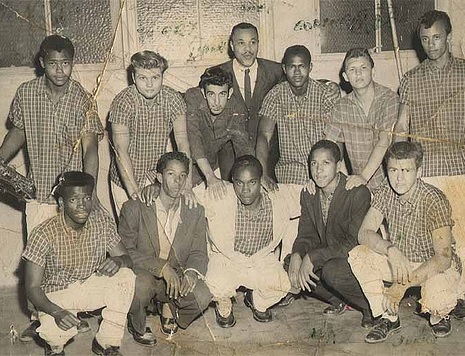 Thanks to this interview you're able to hear "Mice" as a snare drum solo in the shape of a sample of three bars. It's a few figures in 6/8, functional for
passing the little exam. "The Blackouts" from "The lost episodes" isn't a composition, but a conversation taped by Zappa. You have
two members from The Blackouts talking about their appearance at the NCAAP benefit concert at the Shrine Auditorium in Los Angeles. They
were awe-stricken by the size of the event they took part of, featuring among others Louis Armstrong. To the right a group photo with Zappa
standing third from left. Spontaneous and directed dialogues
could sometimes get incorporated in Zappa's albums, as separate tracks or as a part of songs. There are also various examples
of compositions with spoken texts involved. Texts have pitches and rhythms, but no meters. Zappa never went as far as prescribing such
details. He just put the words in an otherwise empty bar or beneath the musically notated notes. This study contains midi files too, so
for constructing them spoken parts are transcribed as how they appear on CD. The interaction between music and language can
be encountered in three ways in Zappa's output:
Thanks to this interview you're able to hear "Mice" as a snare drum solo in the shape of a sample of three bars. It's a few figures in 6/8, functional for
passing the little exam. "The Blackouts" from "The lost episodes" isn't a composition, but a conversation taped by Zappa. You have
two members from The Blackouts talking about their appearance at the NCAAP benefit concert at the Shrine Auditorium in Los Angeles. They
were awe-stricken by the size of the event they took part of, featuring among others Louis Armstrong. To the right a group photo with Zappa
standing third from left. Spontaneous and directed dialogues
could sometimes get incorporated in Zappa's albums, as separate tracks or as a part of songs. There are also various examples
of compositions with spoken texts involved. Texts have pitches and rhythms, but no meters. Zappa never went as far as prescribing such
details. He just put the words in an otherwise empty bar or beneath the musically notated notes. This study contains midi files too, so
for constructing them spoken parts are transcribed as how they appear on CD. The interaction between music and language can
be encountered in three ways in Zappa's output:
- The incorporation of plain spoken text within musical compositions. See for instance the
"Dental hygiene dilemma" and "Heavenly bank account" examples from this study.
- The speech-wise singing or reciting of texts, as in "Montana" or "Do you like my new car?/The groupie routine". See also
the Man from Utopia section from this study.
- The rhythm of musical notes being speech-influenced. See for instance "Drowning witch" (first example) and "Wild love".
Other tracks from The lost episodes
Next to "The Blackouts" and "Lost in a whirlpool", "The lost episodes" contains a series of pieces from the sixties and seventies, that
so far hadn't been released. Except for the covers and spoken tracks, all are coming by in this study:
- "Take your clothes off while you dance": the version from 1961 is included in the Paul Buff section.
- "Ronnie sings - Kenny's and Ronnie's booger story": three oddities from 1961-2, included in the Paul Buff section.
- "Tiger roach": a blues improvisation with Don Van Vliet, also included in the Paul Buff section.
- "Run home, slow": a couple of examples from this movie are included in the Movie scores section,
including the theme and cue #2 and #3.
- "Fountain of love": the version from 1963 is included in the Paul Buff section.
- "Any way the wind blows": idem.
- "Charva": a song included in the Projects section.
- "The big squeeze": music for a commercial, included in the Absolutely free section.
- "Alley cat": a jam from 1969, included in the YCDTOSA V section.
- "The grand wazoo (1969/1992)": a collage coming by in the Outrage at Valdez section.
- "Kung Fu": this version is included in the Burnt weeny sandwich section.
- "RDNZL": this song gets dealt with in the Studio tan section.
- "Basement music #1": synthesizer music, coming by in the Leather section.
- "Lil' Clanton shuffle": blues, described in the Hot rats section.
- "I don't want to get drafted": the original recording of Drafted again, included in the You are what you is.
- "Sharleena": the 1970 version of this track is coming by in the Chunga's revenge section.
